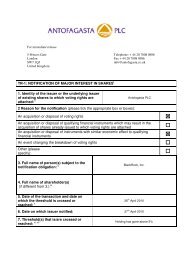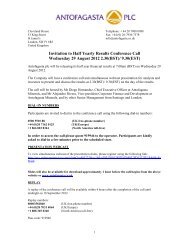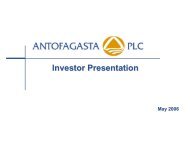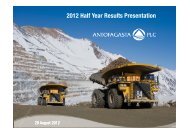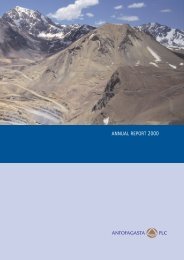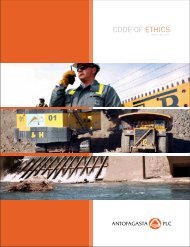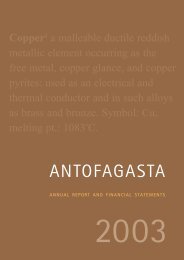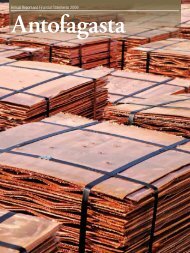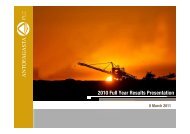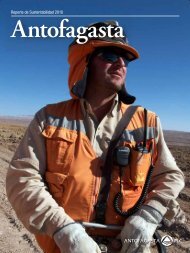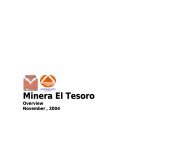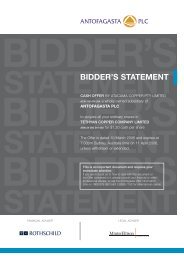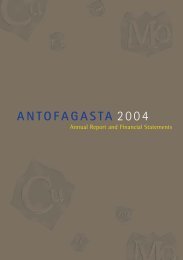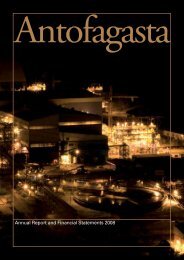Sustainability Report - Antofagasta PLC
Sustainability Report - Antofagasta PLC
Sustainability Report - Antofagasta PLC
You also want an ePaper? Increase the reach of your titles
YUMPU automatically turns print PDFs into web optimized ePapers that Google loves.
Environmental Performance<br />
What is the issue?<br />
Mining operations impact natural<br />
habitats and affect plant and animal<br />
species. There is growing awareness of<br />
the importance of biodiversity<br />
conservation in Chile, and the<br />
government is considering legislation to<br />
create a Biodiversity and Protected<br />
Areas Service which would oversee a<br />
national approach.<br />
Los Pelambres faces the greatest<br />
biodiversity challenge due to its location<br />
and scale. Esperanza, El Tesoro and<br />
Michilla are located in the Atacama<br />
desert, the driest desert in the world,<br />
where fewer animal and plant species<br />
can be found. Los Pelambres,<br />
Esperanza and Michilla must also<br />
protect marine biodiversity at their port<br />
facilities in Los Vilos and Caleta<br />
Michilla.<br />
Biodiversity and land use<br />
<strong>Antofagasta</strong> Minerals 61<br />
<strong>Antofagasta</strong> Minerals recognises the importance of protecting local ecosystems and biodiversity.<br />
Biodiversity protection plans are developed for every mine in compliance with regulations and take<br />
into account the interests of different stakeholders including farmers and landowners, local<br />
communities and non-governmental organisations.<br />
<strong>Antofagasta</strong> Minerals’ efforts to promote biodiversity focus in particular on the Choapa Valley where<br />
Los Pelambres is located. Los Pelambres voluntarily restored land to create a nature sanctuary at<br />
the Laguna Conchali wetlands which have significant biological diversity and are now a park and<br />
local attraction. The site is declared a Wetland of International Importance under the Ramsar<br />
Convention. The mining company has also put in place programmes to protect peat lands and one<br />
of the few remaining Chilean Palm forests. All of these sites provide habitats for endangered<br />
species.<br />
In 2011 Los Pelambres invested in reforestation projects to replace woodland previously cleared for<br />
mining operations, to support local biodiversity and comply with the environmental agreements<br />
governing its mining licences. Esperanza, El Tesoro and Michilla, located in the Atacama desert,<br />
measure and monitor biodiversity for the few species that have been found in the area, such as the<br />
Andean Fox and some migratory birds. In 2011 we developed a ‘flora and fauna field guide’ for<br />
these locations and it will be published in 2012 (see case study page 60). El Tesoro has an agreement<br />
with the Wildlife Rescue and Rehabilitation Centre of the University of <strong>Antofagasta</strong> (CRRFS) to<br />
rehabilitate and release any animals found injured in the area.<br />
Esperanza and Michilla monitor the biodiversity of the marine environment around their shipment<br />
pier located in Caleta Mejillones. Los Pelambres supports marine biodiversity and bird life, as well<br />
as the development of sustainable fishing at Los Vilos through its charity, Fundación Minera Los<br />
Pelambres.<br />
In 2011 El Tesoro began a project to improve the area around the Ojos de Opache desert spring,<br />
clearing more than 5,000 tonnes of waste and debris. This oasis, located 11km west of the city of<br />
Calama, is a natural pool rich in native flora and fauna biodiversity.<br />
<strong>Antofagasta</strong> Minerals applies a land use indicator for measuring the proportion of agricultural land<br />
occupied by its mining facilities. Los Pelambres owns 140,000 hectares of which it has designated<br />
3% (4,380 hectares) for industrial use. Of this 3%, only 13 hectares could be suitable for farming.<br />
Michilla, El Tesoro and Esperanza are located in the desert where farming is not feasible.<br />
Environmental incidents<br />
Chilean environmental law requires mining companies to report operational incidents that result<br />
in an impact on the environment. To increase transparency and consistency, <strong>Antofagasta</strong><br />
Minerals uses a corporate procedure to identify, classify and report these incidents. Sites have<br />
reported all incidents, even minor ones, to the national authority, helping to build trust with<br />
environmental regulators and communities as well as internal awareness within our companies.<br />
In 2011 there were no operational incidents resulting in environmental impact at our sites. El<br />
Tesoro reported four operational incidents to the authorities although none of these is considered<br />
to have had an environmental impact. These are described in detail in El Tesoro’s 2011<br />
<strong>Sustainability</strong> <strong>Report</strong> (pages 108 and 109), available at www.tesoro.cl. In 2011 we paid two<br />
fines totalling US$41,000 that related to incidents in previous years.<br />
Overview<br />
<strong>Sustainability</strong> at <strong>Antofagasta</strong> <strong>Antofagasta</strong> Minerals <strong>Antofagasta</strong> Railway Company Aguas de <strong>Antofagasta</strong> Appendices



